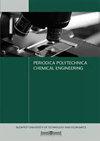Comprehensive Processing of Vanadium-Containing Black Shale Tailings
IF 1.8
4区 工程技术
Q3 ENGINEERING, CHEMICAL
引用次数: 0
Abstract
This article examines results of the thermodynamic modeling of interaction of the briquetted tailings obtained at hydrometallurgical leaching of the vanadium-containing quartzites (black shales) with carbon and iron, determination of Si, V, Fe, C equilibrium distribution and optimal conditions for the formation of various grades of ferrosilicon, as well as the electric melting to produce silicon alloys. The research techniques were the method of thermodynamic modeling using the HSC-6.0 software package (Outokumpu), the second-order rotatable designs (Box-Hunter plans) and electrofusion in an arc furnace. It was established that an increase in the amount of iron from 11 to 39% makes it possible to increase the extraction degree of silicon into an alloy up to 72–73% in the temperature of 1800–2000 °C, in the process the silicon concentration in the alloy decreases from 57–65.7 to 40.5–40.9%; FS45-grade ferrosilicon at the extraction degree of silicon in the alloy of 70–72.6% can be formed in the temperature of 1750–2000 °C in the presence of 29–39% Fe, FS50 ferrosilicon is formed at 25.5–35.0% Fe and 1870–2000 °C, and FS65 ferrosilicon – in the temperature of 1895–2000 °C in the presence of 11–12.7% Fe. The FS45-grade ferrosilicon was formed during electric smelting of a charge containing 57% of the briquettes, 21% of coke, 22% of steel chips, and the FS50-grade ferrosilicon – using a charge consisting of 61% of the briquettes, 22% of coke and 17% of steel chips; the silicon extraction degree into the alloys is 73–79%.含钒黑页岩尾矿的综合处理
本文研究了含钒石英岩(黑页岩)湿法冶金浸出获得的压块尾矿与碳和铁相互作用的热力学模型的结果,确定了Si、V、Fe、C的平衡分布和形成不同等级硅铁的最佳条件,以及电熔生产硅合金的结果。研究方法为利用HSC-6.0软件包(Outokumpu)进行热力学建模、二次可旋转设计(Box-Hunter图)和电弧炉电熔。结果表明,在1800 ~ 2000℃温度下,铁的加入量从11%增加到39%,合金中硅的析出度可提高到72 ~ 73%,合金中硅的浓度从57 ~ 65.7下降到40.5 ~ 40.9%;合金中硅萃取度为70-72.6%的fs45级硅铁在1750-2000℃、铁含量为29-39%时可形成,FS50级硅铁在铁含量为25.5-35.0%、铁含量为1870-2000℃时可形成,FS65级硅铁在铁含量为11-12.7%、铁含量为1895-2000℃时可形成。fs45级硅铁是用含有57%型煤、21%焦炭、22%钢屑和fs50级硅铁的炉料在电熔炼过程中形成的,炉料由61%的型煤、22%的焦炭和17%的钢屑组成;硅在合金中的析出度为73 ~ 79%。
本文章由计算机程序翻译,如有差异,请以英文原文为准。
求助全文
约1分钟内获得全文
求助全文
来源期刊

Periodica Polytechnica Chemical Engineering
ENGINEERING, CHEMICAL-
CiteScore
3.10
自引率
7.70%
发文量
44
审稿时长
>12 weeks
期刊介绍:
The main scope of the journal is to publish original research articles in the wide field of chemical engineering including environmental and bioengineering.
 求助内容:
求助内容: 应助结果提醒方式:
应助结果提醒方式:


